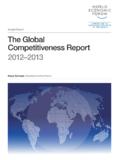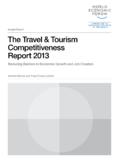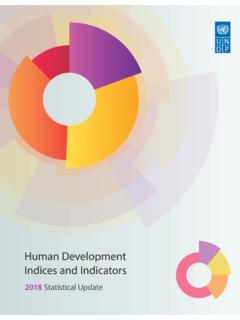Transcription of The Global Economic Burden of Non-communicable Diseases
1 The Global Economic Burden of Non-communicable DiseasesA report by the World Economic Forum and the Harvard School of Public HealthSeptember 2011 World Economic Forum91-93 route de la CapiteCH-1223 Cologny/GenevaSwitzerlandTel.: +41 (0)22 869 1212 Fax: +41 (0)22 786 2744E-mail: 2011 World Economic ForumAll rights material may be copied, photocopied, duplicated and shared provided that it is clearly attributed to the World Economic Forum. This material may not be used for commercial : 080911 The views expressed in this publication are those of the authors alone. They do not necessarily represent the decisions, policy or views of the World Economic Forum or the Harvard School of Public citation: Bloom, , Cafiero, , Jan -Llopis, E., Abrahams-Gessel, S., Bloom, , Fathima, S., Feigl, , Gaziano, T., Mowafi, M., Pandya, A., Prettner, K., Rosenberg, L.
2 , Seligman, B., Stein, , & Weinstein, C. (2011). The Global Economic Burden of Noncommunicable Diseases . Geneva: World Economic online appendix for detailed notes on the data sources and methods: of ContentsPreface 5 Executive Summary 61. Background on NCDs 72. The Global Economic Burden of NCDs Approach 1: Cost-of-Illness Approach 2: Value of Lost Output Approach 3: Value of a statistical Life 313.
3 Conclusion 35 References 38 List of Tables 42 List of Figures 43 List of Boxes 44 Acknowledgements 455 PrefaceNon- communicable Diseases have been established as a clear threat not only to human health, but also to development and Economic growth.
4 Claiming 63% of all deaths, these Diseases are currently the world s main killer. Eighty percent of these deaths now occur in low- and middle-income countries. Half of those who die of chronic Non-communicable Diseases are in the prime of their productive years, and thus, the disability imposed and the lives lost are also endangering industry competitiveness across borders. Recognizing that building a solid Economic argument is ever more crucial in times of financial crisis, this report brings to the Global debate fundamental evidence which had previously been missing: an account of the overall costs of NCDs, including what specific impact NCDs might have on Economic evidence gathered is compelling. Over the next 20 years, NCDs will cost more than US$ 30 trillion, representing 48% of Global GDP in 2010, and pushing millions of people below the poverty line.
5 Mental health conditions alone will account for the loss of an additional US$ trillion over this time span, with dramatic impact on productivity and quality of life. By contrast, mounting evidence highlights how millions of deaths can be averted and Economic losses reduced by billions of dollars if added focus is put on prevention. A recent World Health Organization report underlines that population-based measures for reducing tobacco and harmful alcohol use, as well as unhealthy diet and physical inactivity, are estimated to cost US$ 2 billion per year for all low- and middle-income countries, which in fact translates to less than US$ per rise in the prevalence and significance of NCDs is the result of complex interaction between health, Economic growth and development, and it is strongly associated with universal trends such as ageing of the Global population, rapid unplanned urbanization and the globalization of unhealthy lifestyles.
6 In addition to the tremendous demands that these Diseases place on social welfare and health systems, they also cause decreased productivity in the workplace, prolonged disability and diminished resources within families. The results are unequivocal: a unified front is needed to turn the tide on NCDs. Governments, but also civil society and the private sector must commit to the highest level of engagement in combatting these Diseases and their rising Economic Burden . Global business leaders are acutely aware of the problems posed by NCDs. A survey of business executives from around the world, conducted by the World Economic Forum since 2009, identified NCDs as one of the leading threats to Global Economic growth. Therefore, it is also important for the private sector to have a strategic vision on how to fulfill its role as a key agent for change and how to facilitate the adoption of healthier lifestyles not only by consumers, but also by employees.
7 The need to create a Global vision and a common understanding of the action required by all sectors and stakeholders in society has reached top priority on the Global agenda this year, with the United Nations General Assembly convening a High-Level Meeting on the prevention and control of NCDs. If the challenges imposed on countries, communities and individuals by NCDs are to be met effectively this decade, they need to be addressed by a strong multistakeholder and cross-sectoral response, meaningful changes and adequate resources. We are pleased and proud to present this report, which we believe will strengthen the Economic case for action. Klaus SchwabFounder and Executive Chairman World Economic ForumJulio FrenkDean Harvard School of Public Health6As policy-makers search for ways to reduce poverty and income inequality, and to achieve sustainable income growth, they are being encouraged to focus on an emerging challenge to health, well-being and development: Non-communicable Diseases (NCDs).
8 After all, 63% of all deaths worldwide currently stem from NCDs chiefly cardiovascular Diseases , cancers, chronic respiratory Diseases and diabetes. These deaths are distributed widely among the world s population from high-income to low-income countries and from young to old (about one-quarter of all NCD deaths occur below the age of 60, amounting to approximately 9 million deaths per year). NCDs have a large impact, undercutting productivity and boosting healthcare outlays. Moreover, the number of people affected by NCDs is expected to rise substantially in the coming decades, reflecting an ageing and increasing Global this in mind, the United Nations is holding its first High-Level Meeting on NCDs on 19-20 September 2011 this is only the second time that a high-level UN meeting is being dedicated to a health topic (the first time being on HIV/AIDS in 2001).
9 Over the years, much work has been done estimating the human toll of NCDs, but work on estimating the Economic toll is far less this report, the World Economic Forum and the Harvard School of Public Health try to inform and stimulate further debate by developing new estimates of the Global Economic Burden of NCDs in 2010, and projecting the size of the Burden through 2030. Three distinct approaches are used to compute the Economic Burden : (1) the standard cost of illness method; (2) macroeconomic simulation and (3) the value of a statistical life. This report includes not only the four major NCDs (the focus of the UN meeting), but also mental illness, which is a major contributor to the Burden of disease worldwide. This evaluation takes place in the context of enormous Global health spending, serious concerns about already strained public finances and worries about lacklustre Economic growth.
10 The report also tries to capture the thinking of the business community about the impact of NCDs on their enterprises. Five key messages emerge: First, NCDs already pose a substantial Economic Burden and this Burden will evolve into a staggering one over the next two decades. For example, with respect to cardiovascular disease, chronic respiratory disease, cancer, diabetes and mental health, the macroeconomic simulations suggest a cumulative output loss of US$ 47 trillion over the next two decades. This loss represents 75% of Global GDP in 2010 (US$ 63 trillion). It also represents enough money to eradicate two dollar-a-day poverty among the billion people in that state for more than half a century. Second, although high-income countries currently bear the biggest Economic Burden of NCDs, the developing world, especially middle-income countries, is expected to assume an ever larger share as their economies and populations grow.











